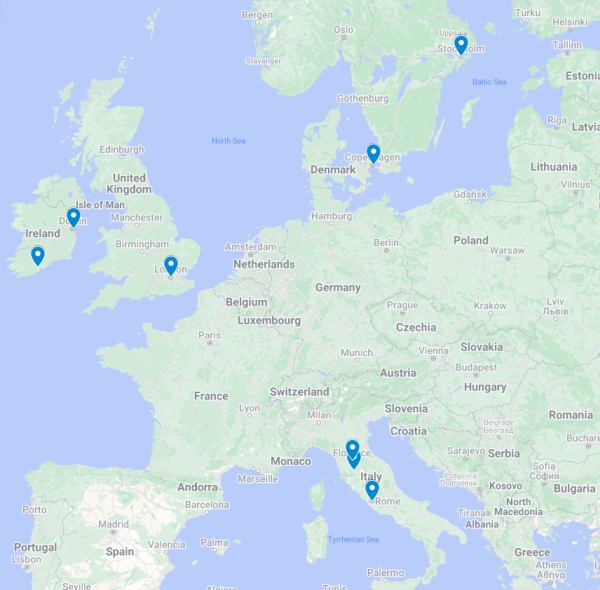Class project embarks to assist refugee population
A box of notebooks, pencils and other school supplies donated by Allegheny College students will be given to the International Institute of Erie as part of a project for a global health transitions class. As part of the project, Diana Armas, ’17, and Jonah Raether, ’18, planned a donation drive to collect school supplies for refugee children around the area. They began planning before spring break in order to start upon the return of Allegheny students, with the idea that the end of the year will bring a surplus of school supplies.
“The IIE was looking for school supply donations for incoming arrivals,” said Armas. “Sometimes they get families with children and they want to set them up with basic necessities.”
Armas and Raether also volunteered in Erie for elementary school students, helping around 15 refugee students after school with studying and homework. Other projects from the class include pamphlets for activity guides for refugees around the area, such as how to get to a certain point of interest, what you will need and how you should interact with people.
“Those topics that we take for granted and we just consider them common knowledge, are not common knowledge to them,” said Armas. “Those presentations are geared towards high school students.”
The class is taught by Caryl Waggett, associate professor of environmental science/studies. The purpose of the assignment was to have the students reach out to a nearby agency and provide services to refugees. This is the third year that Waggett’s class has partnered with the IIE. However, this is the first time assigning this kind of project, according to Waggett. She plans on continuing at least for another year with the small network of other Allegheny professors working with the IIE such as Brian Miller, professor of history.
“The students have absolutely loved the topic of working with refugees,” said Waggett. “They loved having the chance to interact with students on site. They’re very passionate about this topic.”
The IIE is a field office of the U.S. Committee for Refugees and Immigrants, an international refugee advocacy and resettlement organization. The message of the USCRI is, “to address the needs and rights of persons in forced or voluntary migration worldwide by advancing fair and humane public policy, facilitating and providing direct professional services, and promoting the full participation of migrants in community life.”
According to Dylanna Jackson, director of the IIE, it is a not-for-profit organization and receives funding from the government in order to help resettle refugees. The funding starts with an initial $925 for each refugee.
Along with this funding, the IIE receives donations on a daily basis from philanthropic organizations as well as general community members. Donations are received in forms of money, housing, food or even school supplies such as in the case of Armas and Raether’s project. All donations are handed out to refugees when they arrive in Erie.
Erie is comprised of more than 20,000 immigrants with over half of that population being refugees. The demographics stem from all over the globe, but the largest population of refugees come from Bhutan and Bosnia.
“The only growing population in Erie is the refugee population,” said Jackson.
When someone applies for refugee asylum in the United States, they are not allowed to apply to any other country and have to place all their hope on America. After being reviewed for acceptance, the person will go through nearly 20 different steps before arriving in the United States. This application process can often take between 18 months and two years.
The process includes collecting as many documents to prove that the refugee is who they claim to be, as well as numerous screening checks. While this is happening, the refugee will be interviewed at least five times before being allowed to enter the United States, according to the White House website. The majority of this happens outside of the refugee’s origin country, in a refugee camp located in another country.
Once arriving in the United States, they are picked up by the IIE, and given housing, clothing and any other basic necessities.
Outside of the United States, the office of the United Nations High Commissioner for Refugees is an agency mandated to lead and coordinate international action to protect refugees and resolve refugee problems worldwide. According to UNHCR’s website, “it strives to ensure that everyone can exercise the right to seek asylum and find safe refuge in another State, with the option to return home voluntarily, integrate locally or to resettle in a third country.”
In 2014, 59.5 million people around the world were displaced by war, according to a UNHCR annual Global Trends Report in June of 2015. This number is up from 51.2 million people in 2013, and 37.5 million people in 2005. Those displaced are spread throughout the world, with the largest population being sub-Saharan Africa with nearly 4.1 million people. Europe falls close with 3.5 million and the Americas currently having just over 750,000, according to UNHCR.
With such a large number of people, countries need to make a coordinated effort to help refugees, and with the constantly growing number of refugees, Turkey is doing just that. Leading the world in refugee housing with 1.9 million people, it is number one of the top destinations of displaced families, according to a CNN investigation. Over half of the refugees in Turkey are coming from the Syrian civil war. In October 2015 President Obama pledged to take in over 50,000 refugees over the course of the next year. Ten thousand of these refugees will be coming from the Syria.
The global health transitions class is still accepting donations. If you would like to donate please contact Caryl Waggett.
To volunteer or donate goods to the IIE, visit their website at http://refugees.org/field-office/erie/.







